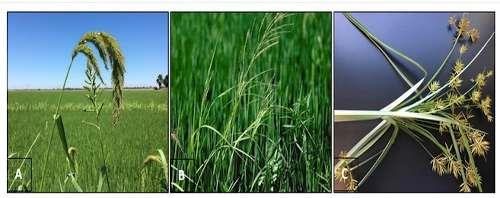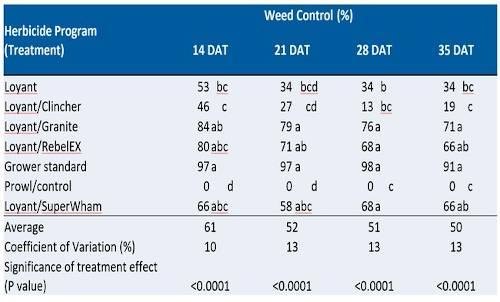By Michelle Leinfelder-Miles
From 2019-2021, we conducted trials to evaluate the efficacy of a new herbicide product called Loyant (florpyrauxifen-benzyl; group 4 herbicide; Corteva Agriscience) in Delta drill-seeded rice. Loyant is registered in rice growing states in the southern US but would be a new chemistry in California. Previous work by the company indicates that Loyant provides good control of broadleaf weeds (e.g. ducksalad, redstems), smallflower umbrella sedge, and ricefield bulrush. Results from 2019 and 2020 Delta trials indicate that Loyant has efficacy on grass weeds in the drill-seeded system, like watergrass and barnyardgrass (Echinochloa spp.). The objective of the 2021 trial was to assess the efficacy of Loyant on yellow nutsedge (Cyperus esculentus) (Figure 1).

Figure 1. The most prevalent weeds in the 2019 and 2020 trials were A) watergrass and barnyard grass (Echinochloa spp.) and B) sprangletop (Leptochloa fusca). The most prevalent weed in the 2021 trial was C) yellow nutsedge (Cyperus esculentus).
Please see the full report for trial methods, including treatment list and rates, and complete results with discussion. In 2021, we observed minor crop injury with all treatments in the form of leaf tip burning, but symptoms were no longer visible two weeks after treatment. No other injury symptoms were observed. In terms of weed control, the best treatment for yellow nutsedge in this trial was the grower standard program, which contained Sandea. Several Loyant treatments performed statistically similar to the grower standard herbicide program and better than the Prowl (“control”) treatment (Table 1). Loyant alone performed statistically worse than the grower standard program in this trial. While Loyant is registered for yellow nutsedge in other states, lack of moisture can impact efficacy. The delay in establishing the permanent flood may have affected its efficacy in this trial. At 64 DAT, we observed that Echinochloa grasses had grown in the Prowl treatment, but they were controlled with the other treatments. The observations agree with the 2019 and 2020 trial results, where Loyant and Loyant tank mixes showed good efficacy on Echinochloa spp.

Table 1. Percent weed control, as plot area, was estimated on 7-day intervals from 14 days after treatment (DAT) to 35 DAT. An untreated area of the field had approximately 1-4 sedges per square foot.
We also had a non-replicated demonstration site (on a different farm) where we evaluated post-flood applications of Loyant alone and in tank mixes. Treatments were applied in late-June, when grasses were heading, with the purpose of evaluating efficacy on grasses that had escaped the pre-flood grower standard program. No crop injury was observed with any treatments. Weed control was compared to a non-treated area outside of the demonstration area. All treatments had efficacy on grasses, but the Loyant/Clincher treatment appeared to work best under these circumstances.
Conclusions:
The purpose of the trial was to learn the crop tolerance and weed control efficacy of Loyant (florpyrauxifen-benzyl) in drill-seeded rice, with the specific objective in 2021 to evaluate efficacy on yellow nutsedge. The best treatment for yellow nutsedge control in this trial was the grower standard program. Loyant, alone, was not efficacious on yellow nutsedge, but performed well in tank mixes with other products. Three years of results trialing Loyant in the Delta drill-seeded system indicate that it could be used in herbicide programs, providing a different chemistry for herbicide resistance management.
Source : ucanr.edu